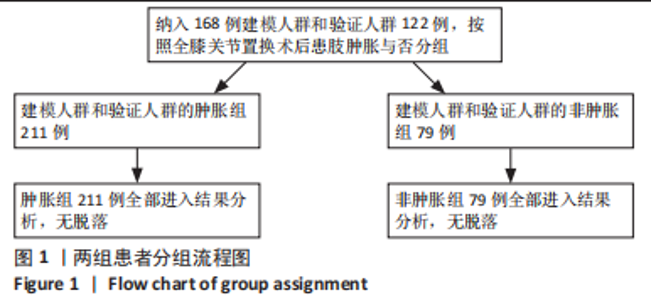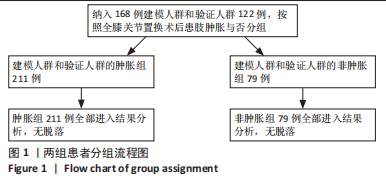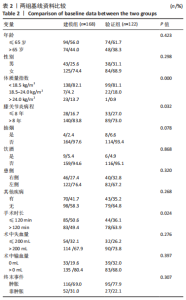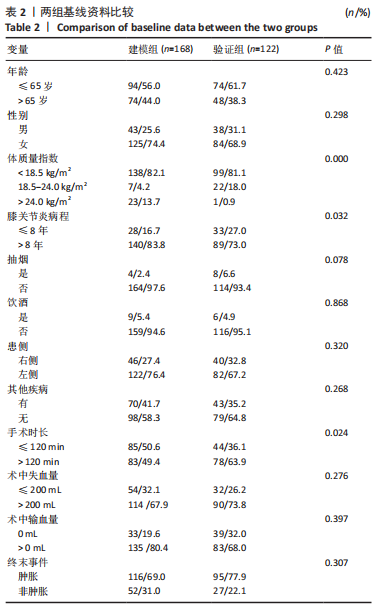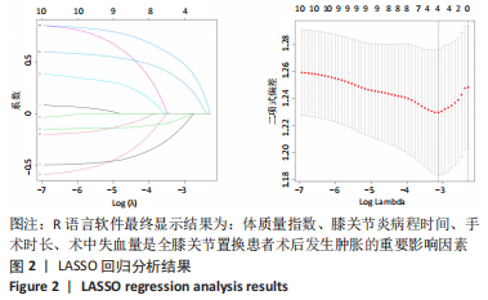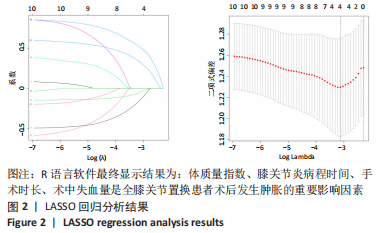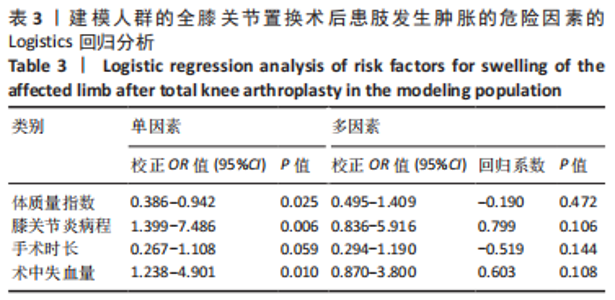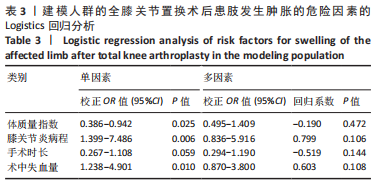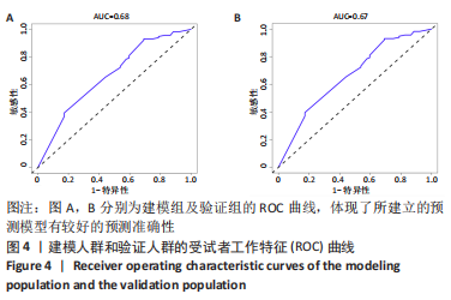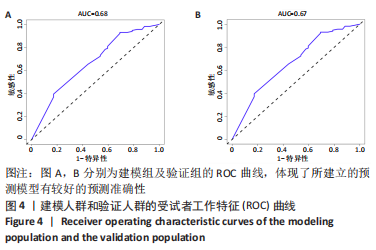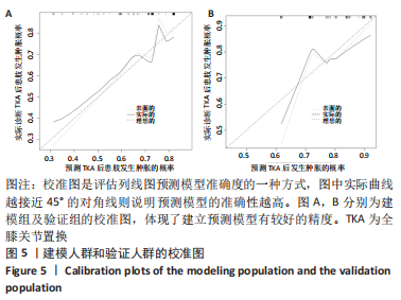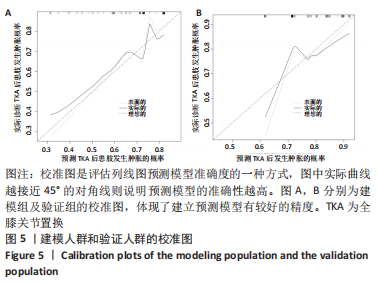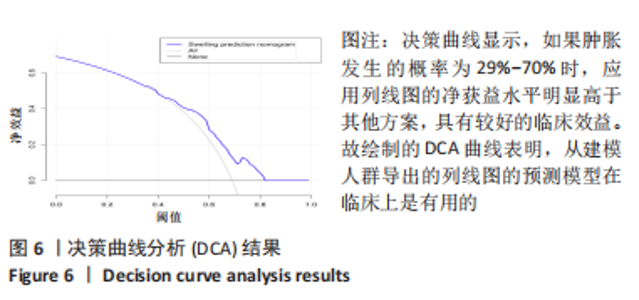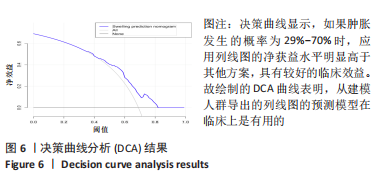Chinese Journal of Tissue Engineering Research ›› 2023, Vol. 27 ›› Issue (22): 3508-3513.doi: 10.12307/2023.357
Previous Articles Next Articles
Establishment and validation of prediction models of affected limb swelling after primary unilateral total knee arthroplasty
Shao Zhuce, Hu Peng, Bi Shuxiong
- Third Hospital of Shanxi Medical University, Shanxi Bethune Hospital, Shanxi Academy of Medical Sciences, Tongji Shanxi Hospital, Taiyuan 030032, Shanxi Province, China
-
Received:2022-03-24Accepted:2022-06-06Online:2023-08-08Published:2022-11-02 -
Contact:Bi Shuxiong, MD, Chief physician, Third Hospital of Shanxi Medical University, Shanxi Bethune Hospital, Shanxi Academy of Medical Sciences, Tongji Shanxi Hospital, Taiyuan 030032, Shanxi Province, China -
About author:Shao Zhuce, Physician, Third Hospital of Shanxi Medical University, Shanxi Bethune Hospital, Shanxi Academy of Medical Sciences, Tongji Shanxi Hospital, Taiyuan 030032, Shanxi Province, China
CLC Number:
Cite this article
Shao Zhuce, Hu Peng, Bi Shuxiong. Establishment and validation of prediction models of affected limb swelling after primary unilateral total knee arthroplasty[J]. Chinese Journal of Tissue Engineering Research, 2023, 27(22): 3508-3513.
share this article
Add to citation manager EndNote|Reference Manager|ProCite|BibTeX|RefWorks
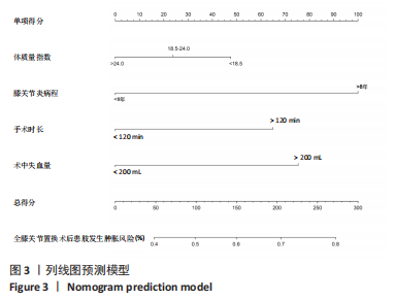
对建模人群进行单因素和多因素的Logistics回归分析,结果发现体质量指数、膝关节炎病程和术中失血量具有统计学意义。 2.6 预测全膝关节置换后患者发生肿胀风险的列线图模型 根据患者的体质量指数、膝关节炎的病程时间、手术时长、术中失血量4个因素绘制成列线图(图3),预测了全膝关节置换患者术后患肢发生肿胀的概率。列线图中,每个变量对终点事件的影响都反映在各自的行长和相应的分数中,不同的患者有个性化的分数,与每个变量相关的总分数构成了全膝关节置换患者术后患肢发生肿胀的概率。结果发现,在所有包含的因素中,患者的膝关节病程时间对术后发生肿胀的影响最明显,术中失血量和手术时长也对肿胀的发生做出了明显的贡献。不同的患者有不同的个性化分数,可以给临床医生提供更多的治疗决策以采取更好的干预措施。"
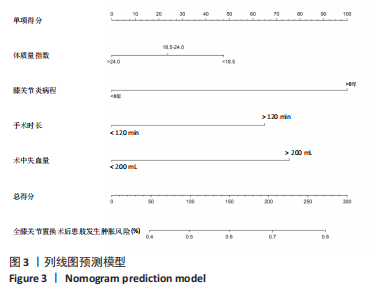
| [1] MISRA D, BOOTH SL, TOLSTYKH I, et al. Vitamin K deficiency is associated with incident knee osteoarthritis. Am J Med. 2013;126(3):243-248. [2] KAYE AD, URMAN RD, CORNETT EM, et al. Enhanced recovery pathways in orthopedic surgery. J Anaesthesiol Clin Pharmacol. 2019;35(Suppl 1): S35-S39. [3] CHAN JJ, CIRINO CM, HUANG HH, et al. Drain Use is Associated with Increased Odds of Blood Transfusion in Total Shoulder Arthroplasty: A Population-Based Study. Clin Orthop Relat Res. 2019;477(7):1700-1711. [4] ZHANG Y, LIU H. Safety of Total Knee Arthroplasty in the Treatment of Knee Osteoarthritis and Its Effect on Postoperative Pain and Quality of Life of Patients. Contrast Media Mol Imaging. 2021;2021:6951578. [5] 高福强, 李子剑, 张克, 等. 初次全膝关节置换术后肢体肿胀的影响因素研究. 中国矫形外科杂志,2011,19(9):724-727. [6] SNYDER MA, SYMPSON AN, SCHEUERMAN CM, et al. Efficacy in Deep Vein Thrombosis Prevention With Extended Mechanical Compression Device Therapy and Prophylactic Aspirin Following Total Knee Arthroplasty: A Randomized Control Trial. J Arthroplasty. 2017;32(5):1478-1482. [7] PICHONNAZ C, BASSIN JP, LÉCUREUX E, et al. Effect of Manual Lymphatic Drainage After Total Knee Arthroplasty: A Randomized Controlled Trial. Arch Phys Med Rehabil. 2016;97(5):674-682. [8] LOYD BJ, KITTELSON AJ, FORSTER J, et al. Development of a reference chart to monitor postoperative swelling following total knee arthroplasty. Disabil Rehabil. 2020;42(12):1767-1774. [9] HOWARD SB, KRISHNAGIRI S. The use of manual edema mobilization for the reduction of persistent edema in the upper limb. J Hand Ther. 2001; 14(4):291-301. [10] VAIRO GL, MILLER SJ, MCBRIER NM, et al. Systematic review of efficacy for manual lymphatic drainage techniques in sports medicine and rehabilitation: an evidence-based practice approach. J Man Manip Ther. 2009;17(3):e80-89. [11] PUA YH. The Time Course of Knee Swelling Post Total Knee Arthroplasty and Its Associations with Quadriceps Strength and Gait Speed. J Arthroplasty. 2015;30(7):1215-1219. [12] RAHMANN AE, BRAUER SG, NITZ JC. A specific inpatient aquatic physiotherapy program improves strength after total hip or knee replacement surgery: a randomized controlled trial. Arch Phys Med Rehabil. 2009;90(5):745-755. [13] RICE DA, MCNAIR PJ, LEWIS GN, et al. Quadriceps arthrogenic muscle inhibition: the effects of experimental knee joint effusion on motor cortex excitability. Arthritis Res Ther. 2014;16(6):502. [14] TORRY MR, DECKER MJ, VIOLA RW, et al. Intra-articular knee joint effusion induces quadriceps avoidance gait patterns. Clin Biomech (Bristol, Avon). 2000;15(3):147-159. [15] HOLM B, KRISTENSEN MT, BENCKE J, et al. Loss of knee-extension strength is related to knee swelling after total knee arthroplasty. Arch Phys Med Rehabil. 2010;91(11):1770-1776. [16] CHRISTENSEN JC, KITTELSON AJ, LOYD BJ, et al. Characteristics of young and lower functioning patients following total knee arthroplasty: a retrospective study. BMC Musculoskelet Disord. 2019;20(1):483. [17] GARRETT BR, WALTERS J. Knee pain, swelling and stiffness after total knee replacement: a survey of South African knee surgeons. SA Orthop J. 2010; 9(2):59-66. [18] BROCK TM, SPROWSON AP, MULLER S, et al. Short-stretch inelastic compression bandage in knee swelling following total knee arthroplasty study (STICKS): study protocol for a randomised controlled feasibility study. Trials. 2015;16:87. [19] MILLER TE, THACKER JK, WHITE WD, et al. Reduced length of hospital stay in colorectal surgery after implementation of an enhanced recovery protocol. Anesth Analg. 2014;118(5):1052-1061. [20] LAU RL, GANDHI R, MAHOMED S, et al. Patient satisfaction after total knee and hip arthroplasty. Clin Geriatr Med. 2012;28(3):349-365. [21] HARADA T, HAMAI S, SHIOMOTO K, et al. Analysis of Factors That Influence Patient Satisfaction After Periacetabular Osteotomy: An Asian Cohort Study. Orthopedics. 2022;45(5):297-303. [22] IASONOS A, SCHRAG D, RAJ GV, et al. How to build and interpret a nomogram for cancer prognosis. J Clin Oncol. 2008;26(8):1364-1370. [23] BALACHANDRAN VP, GONEN M, SMITH JJ, et al. Nomograms in oncology: more than meets the eye. Lancet Oncol. 2015;16(4):e173-180. [24] 马骏, 李国庆, 曹力. 全膝关节置换术中不同压力止血带对术后肿胀及疼痛影响的临床研究[J]. 中国矫形外科杂志,2013,21(13):1297-1301. [25] PINSORNSAK P, PINITCHANON P, BOONTANAPIBUL K. Effect of Different Tourniquet Pressure on Postoperative Pain and Complications After Total Knee Arthroplasty: A Prospective, Randomized Controlled Trial. J Arthroplasty. 2021;36(5):1638-1644. [26] 陈洁, 田义华, 唐永利, 等. 全膝关节置换术后患肢不同体位对肢体肿胀与关节活动度的影响[J]. 重庆医科大学学报,2020,45(10):1506-1508. [27] ZHANG YM, LIU JY, SUN XD, et al. Rivaroxaban improves hidden blood loss, blood transfusion rate and reduces swelling of the knee joint in knee osteoarthritis patients after total knee replacement. Medicine (Baltimore). 2018;97(40):e12630. [28] 高福强, 李子剑, 刘延青, 等. 初次全膝关节置换术后肢体肿胀程度与隐性失血量的相关性研究[J]. 中国矫形外科杂志,2011,19(3):199-202. [29] HAŁAS I. Kinesiology Taping–metoda wspomagająca terapię tkanek miękkich. Prak Fizjoter Reh. 2010;9(10):22-25. [30] WILLIAMS S, WHATMAN C, HUME PA, et al. Kinesio taping in treatment and prevention of sports injuries: a meta-analysis of the evidence for its effectiveness. Sports Med. 2012;42(2):153-164. |
| [1] | Zhang Lichuang, Gao Huali, Wang Jingchao, Lin Huijun, Wu Chonggui, Ma Yinghui, Huang Yunfei, Fang Xue, Zhai Weitao. Effect of tendon manipulation with equal emphasis on muscles and bones on accelerating the functional rehabilitation of quadriceps femoris after total knee arthroplasty [J]. Chinese Journal of Tissue Engineering Research, 2023, 27(9): 1383-1389. |
| [2] | Cui Lianxu, Jiang Wenkang, Lu Dahong, Xu Junrong, Liu Xiaocui, Wang Bingyun. Clinical-grade human umbilical cord mesenchymal stem cells affect the improvement of neurological function in rats with traumatic brain injury [J]. Chinese Journal of Tissue Engineering Research, 2023, 27(6): 835-839. |
| [3] | Shen Lianwei, Zhu Hongliu, Wang Wei. Risk factor analysis of metabolic syndrome and construction of a nomogram prediction model in middle-aged and elderly people [J]. Chinese Journal of Tissue Engineering Research, 2023, 27(5): 657-662. |
| [4] | Wei Bo, Yao Qingqiang, Tang Cheng, Li Xuxiang, Xu Yan, Wang Liming. Advantage of medial pivot prosthesis in total knee arthroplasty via medial subvastus approach [J]. Chinese Journal of Tissue Engineering Research, 2023, 27(4): 552-557. |
| [5] | Wan Guoli, Shi Chenhui, Wang Weishan, Li Ang, Shi Xunda, Cai Yi. Retrospective analysis of the influencing factors of chronic pain after total knee arthroplasty [J]. Chinese Journal of Tissue Engineering Research, 2023, 27(4): 558-564. |
| [6] | Gu Mingxi, Wang Bo, Tian Fengde, An Ning, Hao Ruihu, Wang Changcheng, Guo Lin. Comparison of early efficacy and safety of simultaneous and staged bilateral total knee arthroplasty [J]. Chinese Journal of Tissue Engineering Research, 2023, 27(4): 565-571. |
| [7] | Zhang Jinbiao, Li Xiaoming, Xing Wanlin, Ma Fei, Yu Qiaoya, Dai Rongqin. Early warning efficacy of thrombus molecular markers after total knee arthroplasty in patients complicated with venous thromboembolism [J]. Chinese Journal of Tissue Engineering Research, 2023, 27(4): 572-577. |
| [8] | Xu Xiangjun, Wang Chao, Song Qunshan, Li Bingyan, Zhang Jichao, Wang Guodong, Dong Yuefu. Optimal angle for prosthesis implantation in total knee arthroplasty [J]. Chinese Journal of Tissue Engineering Research, 2023, 27(4): 612-618. |
| [9] | Xu Yangyang, He Peiliang, Meng Qingqi, Li Siming. A meta-analysis of the effects of continuous adductor canal block and continuous femoral nerve block on early activity after knee arthroplasty [J]. Chinese Journal of Tissue Engineering Research, 2023, 27(4): 640-645. |
| [10] | Chai Hao, Yang Deyong, Zhang Lei, Shu Li. 3D printing personalized osteotomy guide technology versus conventional total knee arthroplasty on the accuracy of lower limb force alignment: a meta-analysis [J]. Chinese Journal of Tissue Engineering Research, 2023, 27(4): 646-654. |
| [11] | Hu Wei, Yan Xianke . Effect of posterior cruciate ligament preserving knee prosthesis on gait and lower extremity venous return in varus knee arthroplasty [J]. Chinese Journal of Tissue Engineering Research, 2023, 27(22): 3503-3507. |
| [12] | Cheng Jianjun, Ding Ya, Dong Lei, Pan Tan, Li Xinglong, Yu Haiyang, Wang Hongliang. Efficacy and safety of combined use of tranexamic acid in total knee arthroplasty [J]. Chinese Journal of Tissue Engineering Research, 2023, 27(22): 3514-3520. |
| [13] | Zhou Hongxing, Zhang Baojian, Yuan Xiangsheng. Recent evaluation of individual biological acetabular cup application in hip revision [J]. Chinese Journal of Tissue Engineering Research, 2023, 27(22): 3521-3525. |
| [14] | Huang Huida, Huang Yongming, Zhou Junde, Liu Wenbo, Lin Yuewei, Su Haitao. Comparison of two techniques in locating tibial prosthesis during total knee arthroplasty of varus knee [J]. Chinese Journal of Tissue Engineering Research, 2023, 27(13): 2038-2043. |
| [15] | Wu Qian, Liu Lingfeng, Li Lisong, Lu Yingjie, Zhou Liyu, Xu Wu, Huang Lixin, Jiang Dinghua. Deep vein thrombosis distribution and risk factors after total knee arthroplasty during enhanced recovery after surgery [J]. Chinese Journal of Tissue Engineering Research, 2023, 27(13): 2044-2050. |
| Viewed | ||||||
|
Full text |
|
|||||
|
Abstract |
|
|||||
